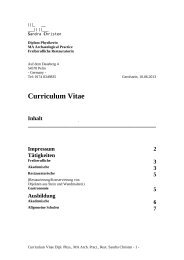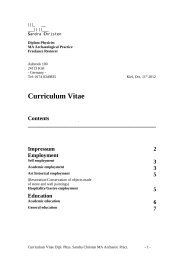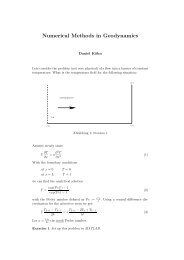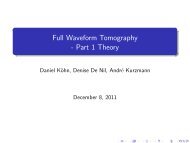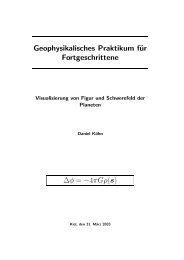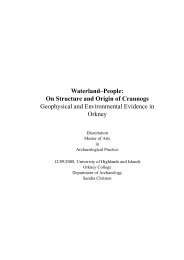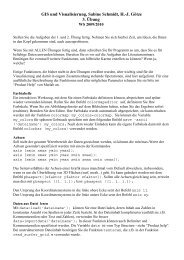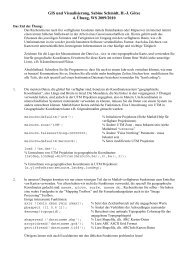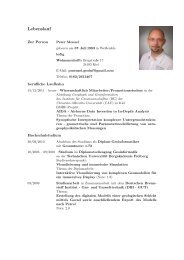Waterland–People: On Structure and Origin of Crannogs ...
Waterland–People: On Structure and Origin of Crannogs ...
Waterland–People: On Structure and Origin of Crannogs ...
You also want an ePaper? Increase the reach of your titles
YUMPU automatically turns print PDFs into web optimized ePapers that Google loves.
2.2. HISTORICAL OVERVIEW CHAPTER 2. GENERAL REVIEW<br />
surveys revealed settlements in wet environment in the Italian Po-valley, in northern<br />
Germany, Sweden, Scotl<strong>and</strong> <strong>and</strong> Irel<strong>and</strong> but the chronological evidence, strengthened<br />
by material cultural <strong>and</strong> environmental evidence showed that the settlements around the<br />
alps were unique <strong>and</strong> earlier than any other sites (Schlichtherle 1997b, 7). The central<br />
European dendrochronological data reaches as far as 8000 BC <strong>and</strong> it is well known that<br />
the lake site settlement pattern spread from 6000 BC from Banyoles in Catalunya <strong>and</strong><br />
the Lago di Bracciano in Latium towards <strong>and</strong> around the northern Alps, with the event<br />
horizon <strong>of</strong> wetl<strong>and</strong> settlements beginning in Bavaria/southern Germany after 3800 BC<br />
(Schlichtherle 1997b, 13).<br />
Scottish Crannog research really began in 1863 when Dr. J. Grigor (Grigor 1863) found<br />
<strong>and</strong> excavated a Crannog in the drained Loch <strong>of</strong> the Clans. He interpreted the rectangular<br />
structure he found below previous water levels as house walls, implying the assumption<br />
that the water levels were much lower at the time <strong>of</strong> inhabitation <strong>and</strong> construction. He<br />
even concludes that the way the construction was set upon a structural floor was chosen<br />
to keep the floor dry (Grigor 1864, 333).<br />
Despite this evidence, that resembles the dry floor constructions <strong>of</strong> houses in wetl<strong>and</strong>s<br />
around the Alps (Schlichtherle 1997a, 95), rectangular structural deposits in Crannog<br />
substructures are currently not interpreted as former dwellings above a lower water<br />
level but as structural deposits, initially drowned to carry the super structural houses<br />
on top. There is, indeed, no reason to reject the assumption that the raised floor level<br />
<strong>of</strong> a dwelling can represent the transitory state <strong>of</strong> rising water levels that evolves into<br />
a structure that rests entirely above water levels as the household is kept on the same<br />
location for generations. The sub structural remains <strong>of</strong> former dwellings can easily<br />
become included in the pile up <strong>of</strong> domestic deposits <strong>and</strong> will support piles driven into<br />
them easily.<br />
The next Scottish researcher was Lord Dowalton who reported another five substantial<br />
<strong>and</strong> six single stone mounds in Loch Dowalton when it was drained. Millar’s Cairn, one<br />
<strong>of</strong> the sites was then excavated by John Stuart, a secretary <strong>of</strong> the Society <strong>of</strong> Antiquaries<br />
<strong>of</strong> Scotl<strong>and</strong>, <strong>and</strong> showed vertical piles mortised into horizontal bars in frames <strong>of</strong> beams<br />
<strong>of</strong> oak (Stuart 1866, 116).<br />
The later truly pioneering research by Dr. Robert Munro included excavations <strong>and</strong><br />
detailed drawings <strong>and</strong> plans <strong>of</strong> hundreds <strong>of</strong> finds <strong>and</strong> locations. ’Buston’ (now referred<br />
to as Buiston) crannog, which he excavated long before work there commenced in 1991<br />
(Crone 1991) seemed to show evidence <strong>of</strong> pre–Iron Age activity, as, similar to finds<br />
from early irish excavations, ’Pottery is represented by numerous fragments, some <strong>of</strong><br />
which are <strong>of</strong> so–called Samian ware, but the most <strong>of</strong> them are <strong>of</strong> vessels <strong>of</strong> a glazed<br />
ware while a few are <strong>of</strong> an archaic type.’ (Munro 1886, 460). ’[...]a quantity <strong>of</strong> round<br />
pebbles <strong>and</strong> so–called sling–stones. [...] a very large percentage <strong>of</strong> the articles consist<br />
<strong>of</strong> querns, hammer–stones, polishers, flintflakes, <strong>and</strong> scrapers; [...]’ Munro even goes so<br />
far as to imply the longevity <strong>of</strong> crannogs as permanently occupied places <strong>of</strong> domestic or<br />
other activity to account for the character <strong>of</strong> their finds <strong>and</strong> mentions the ongoing debate<br />
with Mr. G. Atkinson <strong>and</strong> Mr. A. Lewis, about their comparativeness to the dwellings<br />
<strong>of</strong> the Nicobar <strong>and</strong> other polynesian Isl<strong>and</strong>ers, the debate, at that time, being generally<br />
the same as today <strong>and</strong> concluding in a preliminary statement <strong>of</strong> undoubted logic: ’[...]<br />
6



